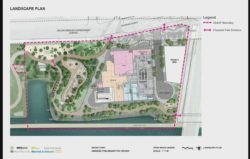
Site Layout Image Credit: City Planning
Council Subcommittee approves Bronx Point after initial concerns on affordable housing and workers compensation. On September 18, 2019, City Council’s Subcommittee on Landmarks, Public Siting and Maritime Uses unanimously approved the Department of Housing Preservation and Development’s UDAAP application to facilitate the creation of “Bronx Point.” The project proposes 1,045 housing units, 540 of which dedicated to permanently affordable housing, a waterfront esplanade, and community facilities including a new state-of-the-art movie theater and a Universal Hip Hop Museum. The property is located north of East 150th Street, south of Mill Pond Park, east of the Harlem River, west of Exterior Street/Major Deegan Expressway. To read in more detail and about the many other features of the Bronx Point development read previous coverage here.
The UDAAP is being requested to allow the developers and HPD to route some of the $200 million investment funding from the Lower Concourse Infrastructure Investment Strategy, to the development’s open space improvements. UDAAP designations generally provide tax incentives to rehabilitate or construct housing on formerly city-owned land. As part of the development agreement, the developer will continually allocate funds to help maintain the open space.
The subcommittee held a public hearing on September 5, 2019. The application team’s presentation dealt primarily with the development’s open space improvements, as they relate to the UDAAP request.
The application team credits over twenty meetings with the local community for the final design of the open space. The goal of the open space’s design is to seamlessly integrate the open space into Mill Pond Park and extend river access. The application team hopes that the riverfront esplanade will continue to extend south on the Harlem River as development in the area continues.
The applicant team purports that a major concern of the community is that privately owned public spaces often feel as though their use is intended for the residents of the development, not for the community at large. To combat this concern, the applicant worked to create visual and pedestrian access through the site, to the water and to the 2.8 acres of open space.
The other highly requested components for the open space include an extended barbecue area, enhanced lighting for safety purposes, an area for dancing and yoga, an adult fitness area, shaded views of the waterfront and a playground for multiple ages. The applicants accommodated each of those community requests. As specifically requested, the large playground also includes water features and a special play structure designed for autistic children.
In light of being situated on the riverfront, the developers made a concerted effort to elevate the site. Elevation will make a more sustainable development and protect against future water impact.
At the public hearing, Council Member Adrienne Adams questioned the applicants about the measures taken to ensure the workers would have proper wage and benefit rates. HPD was unable to comment at that time but promised to follow up with the Council Member.
Council Member Inez Barron subsequently questioned the application team on the affordability of residential units. She pointed out that the apartments are designed for Area Median Income (“AMI”) from 30 percent to 130 percent. While admitting the area’s income in is on the lower end, the application team and HPD claims that over 60 percent of the units are tax credit eligible. The Units that make up 100 percent to 130 percent AMI purportedly make up only a small portion of the total units.
Bronx Point was unanimously approved by City Council on September 25, 2019.
By: Jason Rogovich (Jason Rogovich is the CityLaw Fellow and New York Law School Graduate, Class of 2019)

